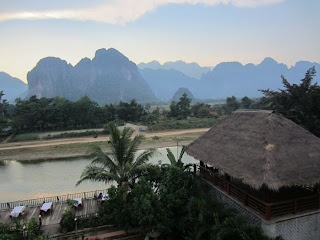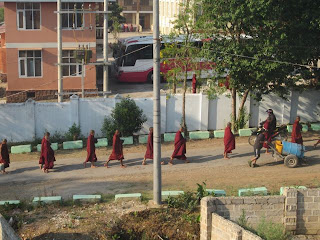Three days in Luang Prabang, with its French influence, was a wonderful experience. Here we could have good coffee and croissants for breakfast and Lao food for supper. The town is full of old colonial buildings squeezed beside those of Lao origin. The buildings have been carefully restored over the last 30 years as this beautiful country has begun to open up to the world. The French influence is strongly felt, although France withdrew many years ago and the country is now governed by a socialist government. The country is officially known as the Lao Peoples Democratic Republic.
Scattered throughout the city are many temples (Wats). There is a large monastic community here. The morning rounds to gather alms is a daily ritual. Devout buddhists make merit by offering rice and other foods to the monks. The sight is impressive as hundred of saffron-robed monks of all ages walk down the street at dawn. Locals kneel to put alms in the alms bowls carried by the monks. The ritual has become a major draw for tourists, somewhat spoiling the anticipated serenity of the scene. Despite written signs appealing to tourists to be quiet and not to stand close to the monks and their devotees, the opposite seemed to occur.
There is a beautiful palace where the last king actually lived until he was exiled to a reeducation camp sometime after 1975. You can see the old cars used by the royal family: Lincolns, a Citroen and a Ford Fairlane, including pictures of drivers of the court that worked until that time. In the centre of town is Mount Phousi on the top of which is a temple and lower down a monastery. The climb up is worth the effort because it allows a view of the town of Luang Prabang, the surrounding area and the two rivers, the Mekong and the Nam Kong that bisect the town.
During the 1970's eastern Laos was victim of an American secret bombing campaign, and was hit as the US targeted communist bases and the Ho Ch Minh trail. It is said that from 1964 to1973 more bombs were dropped here than on the whole of Europe during WWII.
We visited Kuangsi water fall, 25 km outside of Luang Prabang and were able to climb 3/4 of the way up. There we found pools of turquoise water, a great relief after the hike up. There are many caves and water falls in this country. 70% of Laos is mountainous, covered with forests where rare wild animals live. Laos is called the country of 1 million elephants. It is also the less populated country in SE Asia, with just over 5 million people.
Kuangsi Waterfall
From Luang Prabang we took the VIP bus (why VIP we could not figure out other than it being much higher that the regular buses) over a winding mountainous road to Vang Vieng. This is a bumpy six hour ride, over high ridges then plunging down to fertile valleys. The view is magnificent. Tall limestone mountains, called karsts, jut out abruptly as the road goes higher and higher. The town of Vang Vieng is surrounded by these mysterious hills. Pierre is reminded of Jurassic Park and Avatar, which may help you visualize the effect.
And today we are enjoying a heavy downpour, cooling things off. It will be a day of getting laundry done, perhaps a massage by a local woman down the street and just relaxing. As I write this, the mountains are beginning to appear out of the mist. If the weather holds we can explore the area on scooter. Then tomorrow we are off by bus to Ventiane, with destination Hanoi, Vietnam after that.
Scattered throughout the city are many temples (Wats). There is a large monastic community here. The morning rounds to gather alms is a daily ritual. Devout buddhists make merit by offering rice and other foods to the monks. The sight is impressive as hundred of saffron-robed monks of all ages walk down the street at dawn. Locals kneel to put alms in the alms bowls carried by the monks. The ritual has become a major draw for tourists, somewhat spoiling the anticipated serenity of the scene. Despite written signs appealing to tourists to be quiet and not to stand close to the monks and their devotees, the opposite seemed to occur.
There is a beautiful palace where the last king actually lived until he was exiled to a reeducation camp sometime after 1975. You can see the old cars used by the royal family: Lincolns, a Citroen and a Ford Fairlane, including pictures of drivers of the court that worked until that time. In the centre of town is Mount Phousi on the top of which is a temple and lower down a monastery. The climb up is worth the effort because it allows a view of the town of Luang Prabang, the surrounding area and the two rivers, the Mekong and the Nam Kong that bisect the town.
Luang prabang street
During the 1970's eastern Laos was victim of an American secret bombing campaign, and was hit as the US targeted communist bases and the Ho Ch Minh trail. It is said that from 1964 to1973 more bombs were dropped here than on the whole of Europe during WWII.
We visited Kuangsi water fall, 25 km outside of Luang Prabang and were able to climb 3/4 of the way up. There we found pools of turquoise water, a great relief after the hike up. There are many caves and water falls in this country. 70% of Laos is mountainous, covered with forests where rare wild animals live. Laos is called the country of 1 million elephants. It is also the less populated country in SE Asia, with just over 5 million people.
Kuangsi Waterfall
From Luang Prabang we took the VIP bus (why VIP we could not figure out other than it being much higher that the regular buses) over a winding mountainous road to Vang Vieng. This is a bumpy six hour ride, over high ridges then plunging down to fertile valleys. The view is magnificent. Tall limestone mountains, called karsts, jut out abruptly as the road goes higher and higher. The town of Vang Vieng is surrounded by these mysterious hills. Pierre is reminded of Jurassic Park and Avatar, which may help you visualize the effect.
And today we are enjoying a heavy downpour, cooling things off. It will be a day of getting laundry done, perhaps a massage by a local woman down the street and just relaxing. As I write this, the mountains are beginning to appear out of the mist. If the weather holds we can explore the area on scooter. Then tomorrow we are off by bus to Ventiane, with destination Hanoi, Vietnam after that.
































